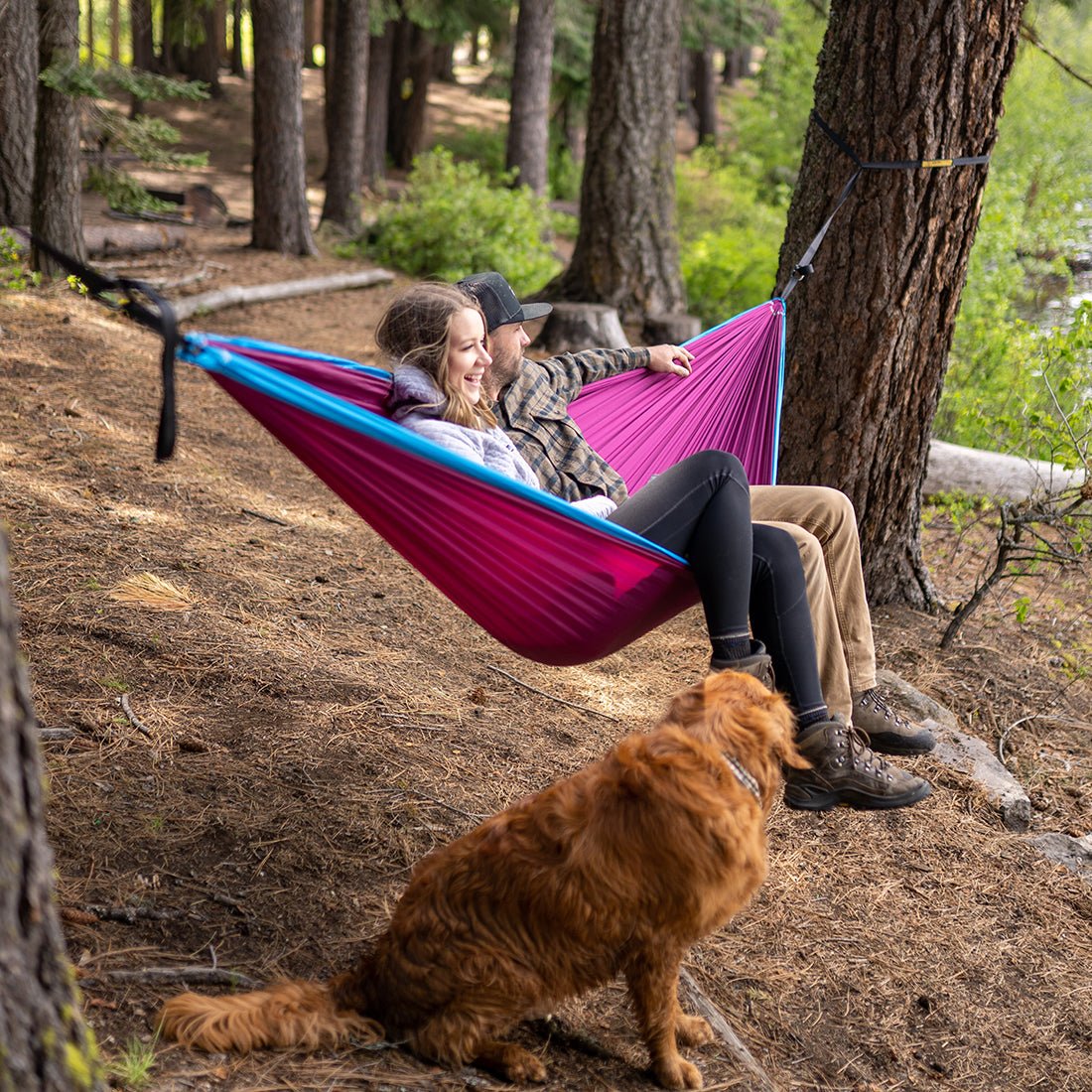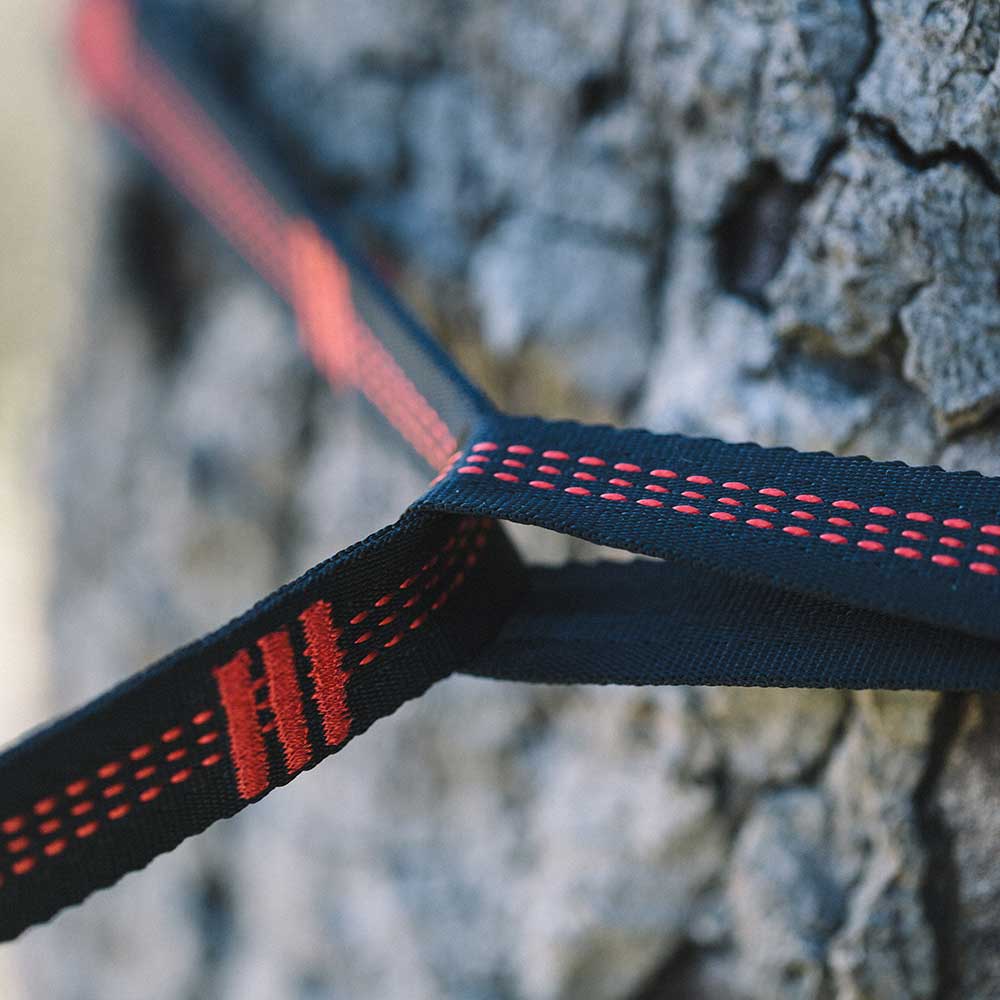Finding the right distance between trees is fairly easy if you are camping in the woods. But if you are trying to hang a hammock in your backyard or at a campsite you may not be blessed with the perfect hanging distance.
This article discusses the ideal distance for hanging hammocks between two trees, depending on your hammock style and length. It also looks at the minimum distance you need to hang your hammock, as well as the maximum distance, and what the implications of that are.
Finally, it offers some tips on choosing trees and what to do if you can't find an acceptable hanging distance.
But before all that, you'll need the right kit before you start to hang your hammock! So be sure to check out the Wise Owl tree straps and hanging kit in the shop...

The Ideal Distance Between Trees for Hanging Your Hammock
For standard 11' gathered end hammocks, you probably want your hanging points to be around 6' off the ground and 15' apart.
That's the simple answer.
Things can get a bit more complicated! (It's also worth saying that a bit of trial and error can help find the setup that you find most comfortable -- so don't be afraid to test out different distances to see what works best for you).
Height
Arguably when hanging a hammock, the height at which you attach your straps (so that you can achieve the ideal sit height as well as a flat lie) is more of a limiting factor than the actual distance.
In theory, you can hang your hammock at whatever distance you want (beyond the minimum). But because you're looking for a 30° angle on your hang PLUS you need to be able to actually get into your hammock, the further you go, the higher you need to hang your hammock.
You can use a hammock hang calculator to make sure you achieve an optimal height / distance combination. But as an indication, if the distance between anchor points is your typical 15', then you'll want your straps to be about 5' 10" high. By the time you get to 20' apart, then the ideal hang height becomes 7' 3" off the ground which starts to become a challenge for anyone without a ladder!
Hammock Length
The length of your hammock dictates the minimum distance, because if the distance is shorter than your hammock then you won't be able to hang your hammock properly (obvious, right?).
As a rule of thumb, you're looking for a space that's 3-4 feet longer than the total length of your hammock. (So for a 9' hammock like the SingleOwl, a space of 12' to 13' is ideal). There's a bit of a difference between the optimum distance for gathered end hammocks and spreader bar hammocks which is discussed below.
To measure the length of your hammock (if you don't already know it), it is worth laying it flat on the ground. The measurement you want to take is ring to ring. It can be worth doing this exercise even if you do think your know the length, because manufacturers can sometimes advertise the bed length rather than the ring to ring length.
Again, if you want to be more precise, then you can use a hammock hang calculator.
Spreader Bar Hammock vs Gathered End Hammock
Spreader bar hammocks keep your hammock open and are more like a flat bed. This means with spreader bars you need more tension than when hanging a gathered end hammock.
The minimum distance for a spreader bar hammock is the length of the hammock (ring to ring).
The minimum for a gathered end hammock is the length of your hammock plus a foot either side (so, 2ft in total).
What if You’re Using a Tarp?
If you're using a hammock tarp then you're probably looking for a gap that will accommodate your tarp more than your hammock (because your tarp should be longer than your hammock).
While this is less important the further apart the trees are, it is a serious consideration if you are using a large tarp or if the gap between trees is especially tight.
The point is this: the last thing you want is to set your hammock up perfectly between the trees, step back, admire how well hung it is only to realize you haven't yet hung your tarp and it won't fit.
What if the Hanging Distance is Far Apart?
If trees are further apart than you'd like it should still be possible to hang your hammock. The main issue is that the further apart you go, the higher you have to hang your straps in the tree (and you may even need extra straps).
You can definitely mitigate this by using a ridgeline.
But even if you can't find the perfect trees, you can anchor to a single tree and use something else for the second anchor point.
Place Your Hammock Straps Higher up the Tree
When hanging your hammock you ideally want a 30 degree angle in order to get the right sag. You also need the average height of your hammock to be low enough to get in and out easily.
These two factors mean that the further apart your trees, the higher you have to place your straps, otherwise your hammock will be on the ground (or you will have the incorrect sag).
At around 20' distance, you'll need your straps to be well over 7' off the ground. And so this is generally considered the maximum distance for hanging a hammock.
Use a Ridgeline
If your trees are the right distance apart you should be able to get the right sag without a ridgeline. However, when the trees are further apart than you'd like, throwing up a rope and making a ridgeline will prove invaluable.
Still Too Far? Find Another Anchor Point
The reality is that you don't actually need two trees to set up a hammock. If you can't find two trees the right distance apart then use one tree and a different anchor point.
Hammock enthusiast and woodworker, David Goodell says that he likes to take a madera hammock stand with him. They can run you a hundred bucks online but he made his own for less than $10.
"Madera hammock stands give you so much more flexibility when hammock camping because it means you always have an anchor point and you can put it anywhere you want! They are also one of the simplest woodworking projects you can imagine! All you need is two struts (two lengths of 2x2 timber should be fine), a length of rope and a rebar stake for anchoring".

Safety Considerations When Choosing Trees
When looking for the perfect distance between trees to hang your hammock it might be easy to forget some basic safety protocols. So to avoid serious injuries, make sure to keep these things in mind.
Size of Tree
It's really important your hammock isn't hung on trees that are too small or too young. Ideally you want your trees to be a minimum of 8" in diameter. If you don't want to get your tape measure out then a simple rule of thumb is grab the trunk and give the tree a good shake. If it moves then it's probably too small. Move on.
Dead Branches
Obviously you shouldn't attach your hammock to any dead wood because the chances are it won't support your weight. Worse, it might support your weight for a while and then break when you're asleep (and nobody likes to fall out their hammock while sleeping).
More important than your attachment point is to look up before you hang your hammock. Laurel Robbins from monkeysandmountains.com has lots of experience sleeping in the woods and has this advice:
When you're hanging hammocks, look out for widow-makers -- broken, suspended tree branches. These dead branches can be difficult to spot in dense woods, but one thing to watch for is light-coloured wood coming from the inside of a branch. You definitely don't want your hammock hung underneath one of these and have the branch fall on you in the middle of the night...

Related Questions About Hanging Hammocks
How Do You Hang a Hammock Between Two Trees Far Apart?
If you want to hang a hammock between two trees that are very far apart then you should use extra long hammock straps. But remember, the greater the distance between trees, the higher up the tree trunk you'll need to attach your straps to get the right angle. At more than 20' the trees are too far apart to get a sensible hanging height.
What’s the Maximum Distance Between Trees to Hang a Hammock?
About 20' apart is the maximum distance between trees to hang a hammock. At that distance you'll likely need your hammock straps to be around 7'3" off the ground. Which for most people means that anything more than 20' and the trees are too far apart.
Can You Hang a Hammock From One Tree?
Yes you can hang a hammock from just one tree. You just need to look for other anchor points, like a fence post, or you can use a hammock stand (like a madera stand). Just make sure it can take your weight!








